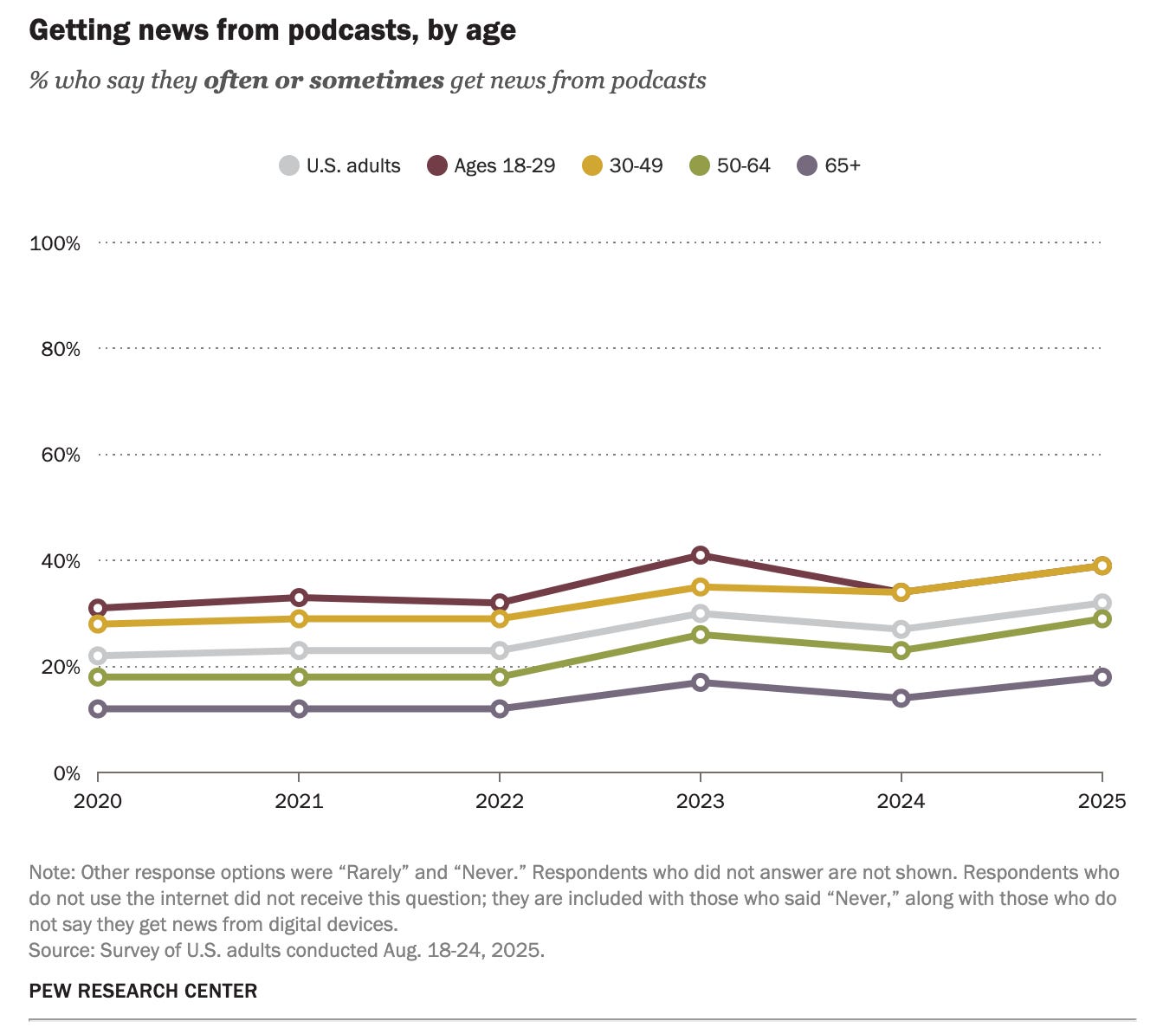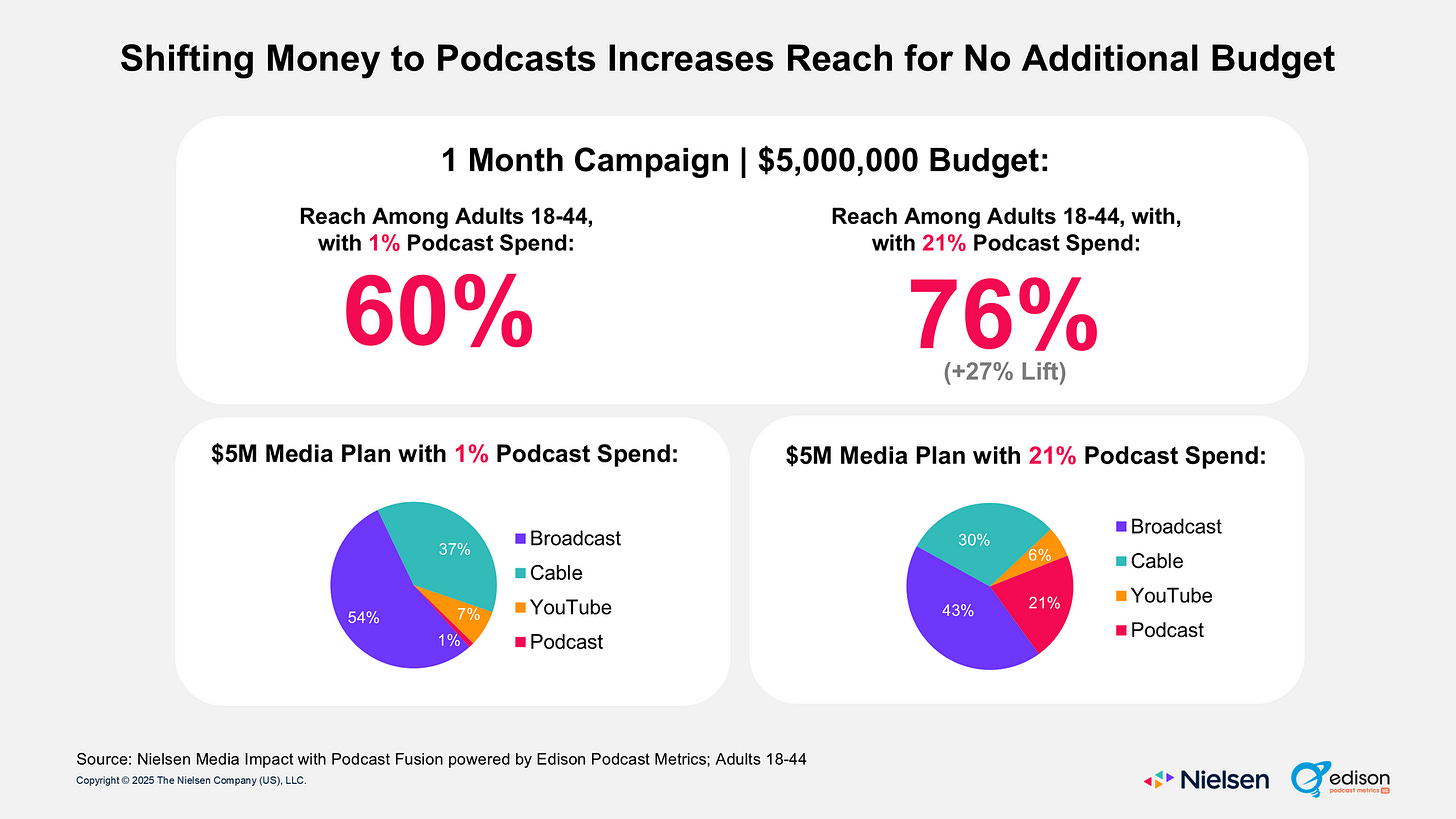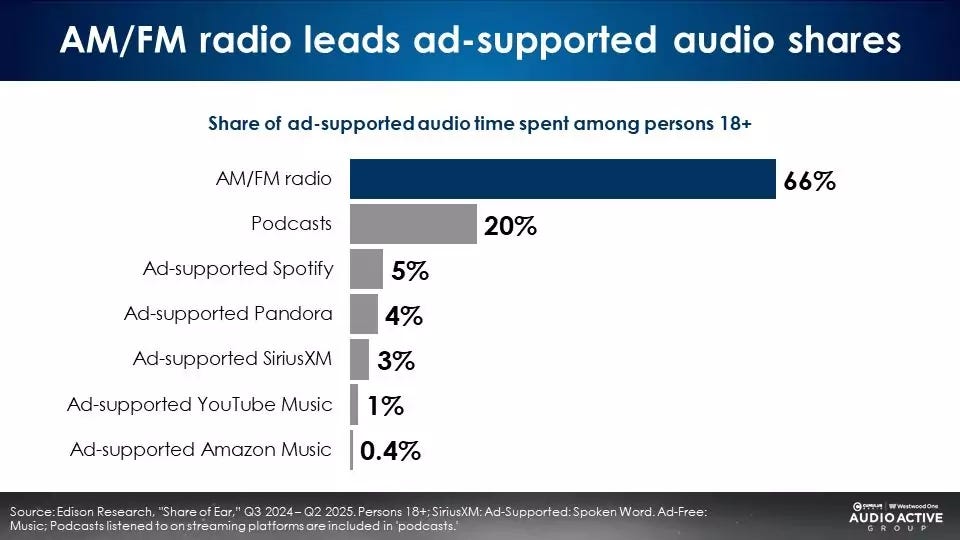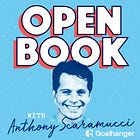Did someone forward this to you?
Become one of the more than 1000 valued email subscribers. Find Out More 👈
👋 Hi, Podsky!
We are thrilled to present the latest Weekend edition of Podcast In Brief! And don't worry, our loyal listeners — you'll still get the occasional real-time update!
Thank you to all our free and paid subscribers for continuing to support us. As an independent media organisation, we can only continue our work with the support of readers like you, unlike others who are supported by well-funded organisations.
Your subscription to Podwires will help to fund our operations as an independent media organisation. Becoming a paid subscriber
First time reading? We would be delighted if you would join us – after all, we have over 1,000 intellectually curious readers already! Sign up here.
We want everyone to know about this, so please spread the word by sharing the email with your friends! (copy URL here)
And, as always, send us feedback at editor@podwires.com
Today's reading time is 5 minutes. - Miko Santos
🎙️Today, we've got the inside scoop on:
One-Third of Americans Now Get News From Podcasts – And the Numbers Tell a Story We Can’t Ignore
Podcasting Finally Gets a Seat at the Big Kids’ Table
The Perception Gap That’s Costing Podcasting Money
We Built the Most Trusted Medium in America. Now What?
One-Third of Americans Now Get News From Podcasts – And the Numbers Tell a Story We Can’t Ignore
The Podwires Rundown : A third of Americans now get news from podcasts. Let that sink in for a moment. When Pew Research Center first asked this question in 2020, it was just 22%. That’s a 45% increase in five years.
But here’s what really matters: younger audiences are leading this shift, with nearly four in ten adults under 50 turning to podcasts for news at least sometimes. The trust gap is fascinating too – Republicans trust podcast news at double the rate of Democrats. This isn’t just about entertainment anymore.
News podcasts have become a legitimate information channel, competing directly with traditional media. And if you’re producing a podcast that touches on current events, you’re now part of a media ecosystem that’s reshaping how millions of Americans understand their world.
According to a new study from Pew Research Center released September 25, 2025, podcast news consumption has grown significantly across all demographic groups over the past five years. The research, based on a survey of U.S. adults conducted August 18-24, 2025, reveals shifting patterns in how Americans consume news and information through on-demand audio.
The Key Points:
32% of U.S. adults now get news from podcasts at least sometimes, up from 22% in 2020 – a 45% increase in five years
54% of Americans have listened to a podcast in the past year, with younger listeners (67% of 18-29 year-olds) far outpacing older demographics (33% of 65+)
Republicans (31%) trust news from podcasts more than other sources at twice the rate of Democrats (15%), revealing a significant partisan divide in podcast news trust
69% of podcast news consumers listen to shows that explain topics in depth, 61% listen to opinion/commentary shows, and 58% consume daily news summaries
Only 6% of Americans financially support news podcasts through subscriptions or donations, despite 17% paying for news sources in general
Why It Matters: This data confirms what many suspected but few could quantify: podcasts have evolved from an entertainment medium into a serious news platform. For podcast creators, this means your content isn’t just competing with other shows – it’s competing with CNN, The New York Times, and local news stations. The trust divide between Republicans and Democrats suggests podcasts are filling gaps left by traditional media, particularly for audiences seeking alternative perspectives. With younger audiences consuming news through podcasts at dramatically higher rates than older generations, this shift represents a fundamental change in media consumption patterns that will only accelerate. If you’re a podcaster who occasionally discusses current events or industry news, you’re now part of the news ecosystem whether you intended to be or not.
The Big Picture : For podcasters and producers, these findings present both opportunity and responsibility. The news podcast space is wide open – with formats ranging from deep dives to daily summaries to commentary all finding substantial audiences.
Nearly 70% of podcast news consumers want in-depth explanations, which plays directly to podcasting’s strengths: long-form, nuanced conversations that traditional media can’t accommodate.
This is actionable: if you’re creating content about your industry, current events, or cultural topics, frame it as news-adjacent and optimize for discovery by news-seeking audiences. The low payment rate (6%) suggests most news podcast listeners aren’t yet in the habit of financially supporting shows, but the high listenership numbers mean advertising and sponsorship opportunities are growing.
For the industry overall, this legitimizes podcasting as infrastructure – not just entertainment, but essential information delivery. That means more investment, more serious content partnerships, and frankly, more scrutiny. The partisan trust gap is a warning sign: as podcasts become a primary news source, the medium needs to maintain credibility across the political spectrum or risk fragmenting into echo chambers. The stakes just got higher.
🛑 BE PODWIRES PAID SUBSCRIBER
As a paid subscriber, you will get all of the following for only $8 a month or $80 a year (or the equivalent in your local currency):
📰 Podwires Job Board - Get the latest Podcast job around the world
🎙️ Podcast Marketplace - 1000 + Independent Podcast Producers ready to help you.
Podwires Superfan - We can keep doing our work with the help of readers like you, unlike other media organisations that get money from big companies.
Podcasting Finally Gets a Seat at the Big Kids’ Table
The Podwires Rundown: For years, podcasting has been the weird cousin at the media planning dinner – invited, sure, but sitting at a separate table. That changed this week. Nielsen Media Impact now includes podcast listening data powered by Edison Research, meaning for the first time ever, media planners can optimize campaigns across podcasts, TV, radio, and digital in one system. This isn’t incremental. This is transformative.
According to Edison Research’s Weekly Insights published October 1, 2025, the integration of Nielsen Podcast Fusion into Nielsen Media Impact represents the first time podcast listening data has escaped the silos of individual measurement systems. Presented at the IAB Podcast Upfronts, the new tool demonstrates how shifting ad dollars to podcasting can increase campaign reach without additional budget – showing a 27% reach growth among adults 18-44 when podcast spend increased from 1% to 21% of a sample media plan.
The Key Points:
Nielsen Media Impact now integrates podcast listening data alongside TV, radio, and digital for the first time, allowing unified cross-platform campaign planning and optimization.
The tool includes Edison Research-powered data on specific podcast networks, genres, and show-level metrics for top programs, not just broad category analysis.
Case study shows moving budget allocation from 1% to 21% podcasting increased reach from 60% to 76% among adults 18-44 with zero additional spend.
Podcasting can now compete for shares of total media budgets rather than only fighting other podcasts for existing podcast-specific dollars.
The system removes guesswork for planners by showing exactly how podcast reach grows by genre, which demos over-index, and impression optimization strategies.
Why It Matters: Until now, podcast advertising has been trapped in its own measurement bubble, making it nearly impossible for major brands to compare podcast performance against other media when building campaigns. Media planners work in Nielsen Media Impact – it’s the industry standard – and if podcasting wasn’t in there, podcasting wasn’t really being considered for major cross-platform campaigns. This integration means podcasting doesn’t just get considered; it gets measured the same way as everything else. For an industry with 115 million weekly listeners in the U.S., that’s the difference between begging for scraps and earning a proper seat at the table.
The Big Picture: For podcasters and producers, this levels up the entire value proposition. When major brands can see – quantifiably, in their planning tools – that shifting budget to podcasting increases reach without increasing spend, suddenly podcasting becomes a strategic imperative rather than an experimental line item. This creates upward pressure on CPMs because the value is finally being measured properly.
Producers should expect more sophisticated conversations with buyers who now have hard data on exactly what podcasting delivers versus other media. The industry as a whole benefits from “growing the pie” of total advertising dollars flowing to podcasting, rather than just dividing up the existing podcast budget among more shows. This is how podcasting stops competing only with itself and starts genuinely competing with TV and digital for major brand dollars. The actionable takeaway? Know your numbers. Understand how your show performs across demographics, what incremental reach you deliver, and be ready to speak the language of cross-platform media planning – because the buyers you’re pitching to certainly will be.
The Perception Gap That’s Costing Podcasting Money
The Podwires Rundown : Here’s a fun party trick: ask a media planner what share of audio time Americans spend with podcasts. Now ask them about AM/FM radio. I’ll wait while you pick your jaw up off the floor, because according to Edison Research’s Q2 2025 Share of Ear study, the answers you’ll get are wildly, almost comically wrong. And that perception gap? It’s costing our industry real money.
The latest quarterly Share of Ear study from Edison Research, published September 29, 2025 by Pierre Bouvard of Cumulus Media | Westwood One Audio Active Group, surveyed 4,000 Americans to measure daily reach and time spent across all audio formats. An accompanying Advertiser Perceptions study from August 2025 asked 302 media agencies and marketers to estimate audience shares, revealing a massive disconnect between perception and reality that particularly impacts how podcasting competes for ad dollars against both traditional radio and streaming audio services.
The Key Points:
Podcasts command a 20% share of ad-supported audio consumption in America, second only to AM/FM radio’s 66% share and significantly ahead of Spotify (5%), Pandora (4%), and YouTube Music (1%).
Media agencies and marketers dramatically overestimate Pandora and Spotify’s combined audience share at 41% when the reality is just 9%, while simultaneously underestimating AM/FM radio by 2.5X.
The combined daily reach of ad-supported Spotify, podcasts, and Pandora is only 31%, meaning digital-only audio plans miss 70% of America, while AM/FM radio reaches 60% daily.
Among younger demographics (18-34 and 18-49), podcasts achieve double-digit in-car listening shares, though AM/FM radio dominates with an 85% in-car share across all demographics.
On smart speakers, podcasts hold a 22% share, trailing only AM/FM radio’s 54% and beating all ad-supported streaming services including Spotify and Pandora.
Why It Matters : Media buyers are making decisions based on vibes, not data. When planners think Spotify and Pandora are 4.5X bigger than they actually are, and they’re underestimating AM/FM radio by more than half, those misperceptions shape where ad budgets flow. For podcasting, sitting at a solid 20% share of ad-supported audio, this perception gap creates both a problem and an opportunity. The problem: we’re competing against inflated expectations of streaming services. The opportunity: when buyers finally see the real numbers, podcasting’s position as the clear #2 in ad-supported audio becomes impossible to ignore.
The Big Picture
For podcasters and producers, these findings should fundamentally change how you position your shows to advertisers. You’re not some experimental digital audio play – you’re commanding one-fifth of all ad-supported audio consumption in America, more than quadruple Spotify’s actual ad-supported share. That’s your opening line. The actionable move here is arming yourself with this Edison data when talking to buyers who’ve been pitched fantasy numbers by streaming services. Show them the 20% share. Show them you’re the only digital audio format breaking double-digits in cars among younger demos. Show them that smart speaker listening puts podcasts ahead of every streaming service except AM/FM radio. The industry benefits when podcasting stops getting lumped into a generic “digital audio” bucket with services that have dramatically smaller actual audiences. We’re not fighting for digital audio scraps – we’re the second-largest ad-supported audio medium in America. Start acting like it. And for producers looking at cross-platform strategies, understanding that 70% of America isn’t reached by digital-only plans means partnerships with AM/FM radio aren’t just nice-to-have, they’re essential for true scale. The data is finally on our side. Use it.
We Built the Most Trusted Medium in America. Now What?

The Podwires Rundown : Podcasting is the most trusted medium in America. More trusted than traditional news. More trusted than social media. We’re a $7 billion global industry reaching over half the U.S. population, delivering one voice to one listener with undivided attention on a recurring basis.
And we’re about to blow it. Because while we’re busy optimizing ad tech and debating video strategy, we’re sleepwalking into the same trap that killed trust in cable news: chasing attention at any cost, with zero sense of civic responsibility. If we don’t wake up now, we’ll squander the last best chance we have to build something better.
In a September 25, 2025 blog post titled “In Defense of Journalism: An Appeal to the Podcast Industry,” Joelle Nole of Larj Media argues that podcasting has become de facto civic infrastructure with the power to shape public understanding, voter behavior, and democratic participation. Citing Pew Research data on podcast trust levels, Signal Hill Insights on news podcast audiences, and high-profile examples like Serial’s impact on the Adnan Syed case and In the Dark’s role in Curtis Flowers’ exoneration, Nole contends the industry faces a historic choice: embrace its civic responsibility or repeat traditional media’s failures.
The Key Points:
Podcasting is now the most trusted medium in America according to Pew Research, surpassing traditional news and social media, with over half the U.S. population listening regularly to a $7 billion global industry.
The industry currently prioritizes ad tech, branded content, and video strategy over civic responsibility, risking the same trajectory that eroded trust in cable news and traditional media.
Podcast platforms like Spotify, Apple, and YouTube function as “the new front page,” shaping public understanding through what they choose to promote and categorize, but lack intentional systems to distinguish journalism from entertainment.
Independent journalists and civic-minded creators lack adequate funding, distribution support, and audience growth strategies compared to influencers and entertainment-focused shows.
The industry needs standardized research measuring how podcasts influence civic understanding, voter behavior, and public trust to legitimize podcasting’s role as democratic infrastructure beyond download metrics.
Why It Matters: Most Americans have lost the ability to distinguish between strongly argued opinion and fact-based journalism, partly because the systems that once supported professional journalism have collapsed while influencer culture has exploded. Podcasting didn’t create this problem, but we’ve inherited the consequences. With traditional news underfunded to the point of irrelevance and public media losing federal funding, podcasting has accidentally become one of the primary ways people understand the world. That’s massive power with zero built-in accountability. If we keep treating podcasting purely as an advertising platform without acknowledging its civic function, we’ll chase the same dopamine-driven engagement metrics that turned cable news into partisan theater. And once trust is gone, we don’t get it back.
The Big Picture : For podcasters and producers, this is uncomfortable but unavoidable: your show matters beyond your download numbers, whether you want that responsibility or not. The actionable reality is that civic-minded content doesn’t have to be boring or unprofitable – Serial proved you can do investigative journalism that becomes a cultural phenomenon, Pod Save America showed you can mobilize millions while building a sustainable business.
But it requires intentional choices. Producers should push clients beyond “podcast as marketing channel” thinking toward “podcast as public impact” positioning, which actually builds stronger audience affinity and attracts mission-aligned sponsors willing to pay premium rates.
For independent creators doing accountability journalism, the industry needs to mobilize around infrastructure: pooled legal defense funds, distribution partnerships with major platforms, and audience development resources that aren’t financially prohibitive. The platforms themselves – Spotify, Apple, YouTube – need to recognize they’re not neutral distributors anymore.
They’re curators of public understanding. Smart categorization that helps audiences distinguish journalism from entertainment isn’t censorship; it’s transparency that protects the trust that makes this entire ecosystem valuable.
And for everyone pitching sponsors or funders: stop leading with reach metrics and start leading with impact. Show them what their money actually does – informs voters, holds power accountable, builds informed communities. The research gap Nole identifies is real: we need industry-wide standards measuring civic impact, not just consumption. Because if we want podcasting treated as essential democratic infrastructure, we need to prove it functions that way. This moment won’t last forever. We either step up now, or we watch podcasting become the next thing people stop trusting.
PRESENTED BY PODWIRES MARKETPLACE
Hire Top Independent Podcast Producers for Your Business
Podcasting is a powerful way to grow business, and Marketplace Podwires is here to assist you in the easy hiring of top-rated independent podcast producers. Be it branded podcasts that share your products with the entire world or internal series aimed at engaging and energizing your teams, our expert producers can craft stories that meet any brief and bring more personality to your brand's voice. Begin with Marketplace Podwires, and find a dream producer for your project today!
MORE FROM PODWIRES:
🎙️ EVERYTHING ELSE IN PODCASTING TODAY
Joe Rogan, Call Her Daddy Among 25 Podcasts Eligible for First Golden Globes Podcast Award. The Golden Globes has announced 25 eligible podcasts—including The Joe Rogan Experience, Call Her Daddy, and SmartLess—that can compete for the new Best Podcast category at the January 11, 2026 ceremony, with only six shows ultimately being nominated.
AI Startup Inception Point Launches 4,000 Podcasts With AI-Generated Hosts, Sparking Industry Debate. While the podcasting industry has largely avoided AI disruption due to its emphasis on authenticity and human connection, startup Inception Point AI is challenging that resistance by producing over 4,000 AI-generated podcasts with synthetic hosts, raising questions about whether artificial intelligence can replicate the intimacy that defines successful podcasts.
Slushno’ Podcast Awards 2025: Ukrainian Audio Content Celebrates Best Culture and Entertainment Shows. Megogo’s “Slushno” Audio Awards 2025 named two Ukrainian podcasts as winners—”Unzip,” a music history show that won awards for best culture/art and entertainment podcast, and “Terror Near the Palace of Sports,” which chronicles the 2015 Kharkiv explosion—recognizing excellence in Ukrainian audio content and podcasting.
New Podcast ‘The Dip’ Explores How International Events Impact U.S. Careers and Economy. Deutsche Welle (DW) has launched “The Dip,” a bi-weekly podcast hosted by journalists Kassandra Sundt and Daniel Winter that explains how global economic events—including AI competition, semiconductor trade, and immigration policy—directly affect American professionals’ careers and finances, with episodes featuring expert interviews and audience Q&A sessions available on major streaming platforms.
SeryeFM Launches to Revive Filipino Radio Drama Tradition Through Digital Streaming Platform. RMN Networks Marketing and Media Ventures has partnered with Podcast Network Asia to launch SeryeFM, Southeast Asia’s first dedicated streaming platform for premium Filipino audio dramas in multiple regional languages including Cebuano, Hiligaynon, and Ilocano, combining RMN’s century-long radio drama legacy with modern podcast technology to deliver serialized storytelling across romance, comedy, and lifestyle genres starting with the original series “Blood in the Barangay” in October 2025.
🚨 Stay on top of your deadlines with our weekly-updated calendar of fellowships, grants, training opportunities and podcasting events. If your organisation has a fellowship, grant or event to share, just 👉 fill out this form or want to contribute an article 👉 click here or reply to this message.
🎧 PODCASTING JOB OPPORTUNITIES
YAP Media - Senior Marketing & Audience Development Specialist
Boston University - Associate Podcast Producer Audio + video
Colorado Public Radio (CPR) - Executive Producer
Dear Media - Sales & Brand Partnerships Associate
The Daily Wire - Vice President, Content Operations
ABC Australia - Supervising Producer Podcasts
👀 Hiring? Or looking for a new job
Grow your business through podcasting. Marketplace Podwires connects you with skilled producers who can craft compelling stories that align with your brand. Start your podcast journey today! 👈

📖 I appreciate you taking the time to read! See you in the next issue. Got a question or criticism? Just click on Reply. We can talk while we are here.
✍️ Give us a press release and a good-sized landscape photo. Make sure it's newsworthy. Send press releases to editor@podwires.com or click here. Editorially, we may rewrite headlines and descriptions.
📬 Sponsor us and get your brand in front of thousands of Independent Podcast Producers and podcasters. Email us at sales@podwires.com for more information or as personal supporters via Patreon, as your contributions help us enhance the experiences of all our users.
🖊️We are delighted to hear from our subscribers! We would be happy to publish your testimonial if you have found our newsletter to be helpful or if you have a success story to share. 👉 Post a Testimonial: https://testimonial.to/podwires
🚀 We are here to help you succeed! Fill out a 5 minute survey and tell us more about your business and yourself. These questions will help us better understand you and promote your business as part of our mission. It’s a win-win!
🚨 Did someone forward this to you?
Become one of the more than 1000 valued email subscribers. Find Out More 👈
We’d love to share what our Podwires readers have been saying!
We’re so grateful to our previous Podwires advertisers!
Podwires is here because of our incredible partners’ unwavering support. The Podwires readers receive journalism free of financial and political influence. If you found this valuable, consider Restacking so more people can see it. Get together with them today.
Thanks to the support of our readers, we can continue to provide free reporting. If you can, please choose to support The Podwires

















